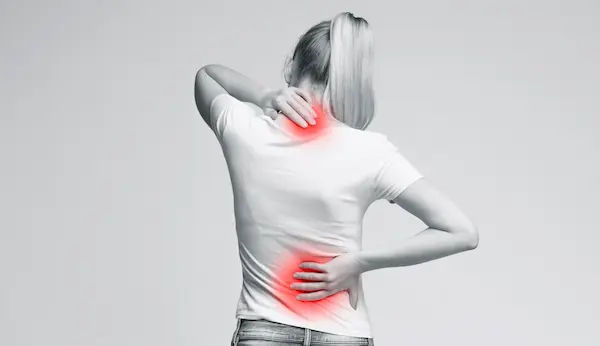Guide to Learn How Treat Muscle Knots Your Own
Muscle knots—also called myofascial trigger points—can cause deep aches, limited movement, and discomfort that interferes with daily life. Learn when home management is enough and when you should consult a doctor or physiotherapist.


Introduction
Muscle knots can appear after a long day working at a desk, after an intense workout, or even due to stress alone. These tight, sensitive spots occur when muscle fibres remain contracted and do not relax properly. They can cause pain locally or radiate to nearby areas, making normal movements feel stiff or uncomfortable. Because muscle knots are common and often preventable, learning how to recognise and treat them yourself is an empowering way to improve your mobility, reduce discomfort, and enhance overall muscle health. This guide explains the causes, symptoms, self-care techniques,
and professional treatment options to help you manage muscle knots effectively and safely.
Consult a Top General Practitioner for Personalised Advice
What Are Muscle Knots?
A quick overview of what muscle knots mean and how they affect muscles.
Muscle knots are small, tight, painful bands within a muscle that form when the muscle fibres contract and fail to release.
They most often occur in the neck, shoulders, back, hips, and calves.
Trigger Points vs Muscle Knots
Trigger points are a type of muscle knot:
- Active trigger points: Cause constant pain and can refer pain to other body regions.
- Latent trigger points: Painful only when touched.
Why Do Muscle Knots Hurt?
Knotted muscle fibres restrict blood flow, causing:
- Accumulated waste products in tissue
- Lack of oxygen to muscle cells
- Pain signals to activate
This creates a cycle of tension and discomfort until treated.
Common Causes of Muscle Knots
Understanding triggers helps you prevent recurrence.
Poor Posture
Slouching or leaning forward causes continuous strain on postural muscles.
Stress and Anxiety
Emotional stress increases muscle tension, especially in the shoulders and neck.
Overuse or Repetitive Movements
Intense workouts or repetitive tasks can overload muscle fibres.
Sedentary Lifestyle
Long periods of sitting reduce muscle activation, promoting stiffness.
Dehydration
Muscles struggle to function and recover when fluid levels are low.
Nutrient Deficiencies
Low magnesium, potassium or vitamin D can increase cramping and tightness.
Injury or Trauma
Strained or torn muscles react by tightening to protect the area.
Symptoms of Muscle Knots
Pain isn’t the only signal that muscle tissue is distressed.
Common signs include:
- Localised soreness or a deep aching pain
- Stiffness or reduced range of motion
- A small, noticeable bump or hard spot in the muscle
- Pain that spreads to the surrounding areas
- Tenderness when pressed
- Muscle weakness or fatigue
Chronic knots may disrupt sleep or cause headaches, especially if in the neck or shoulders.
Self-Treatment Techniques for Muscle Knots
These practical home methods help relax tight muscle fibres and restore mobility.
1️. Heat Therapy
Heat improves blood circulation, reduces stiffness, and promotes relaxation.
How to apply:
- Warm bath
- Heating pad or warm towel
- Hot water bottle
Apply for 15–20 minutes, 2–3 times daily for relief.
2️. Ice Therapy
Ice reduces sharp pain and inflammation, helpful during acute muscle strain.
How to apply:
- An ice pack wrapped in a cloth
- Cold compress
Apply for 10–15 minutes, avoiding direct skin contact.
Alternate heat and ice for stubborn knots.
3. Self-Massage
Massage improves tissue mobility and blood flow.
Technique:
Using fingertips, knuckles, or a massage ball, apply slow, firm pressure to the knot for 30–60 seconds. Gradually increase
pressure but avoid excessive pain.
Massage tools:
- Foam roller
- Lacrosse or tennis ball
- Massage gun
4️. Stretching Exercises
Restores normal muscle length and reduces recurrence.
Examples:
- Neck side stretches for upper trapezius knots
- Chest openers for rounded shoulders
- Hamstring and hip flexor stretches for back pain
Hold stretches for 20–30 seconds, repeat 3–5 times daily.
5️. Hydration and Nutrition
Water supports muscle recovery.
Include magnesium and potassium-rich foods:
- Bananas
- Nuts and seeds
- Spinach
- Whole grains
6. Correct Your Posture
Ergonomics can prevent repeated strain.
Tips:
- Sit upright with shoulders relaxed
- Avoid craning your head forward while using screens
- Adjust chair height to keep feet flat
Consider posture-supportive exercises like yoga or Pilates.
7️. Relaxation Methods
Stress-reduction techniques help muscle tension release naturally:
- Deep breathing
- Meditation
- Warm showers before sleep
When Should You See a Doctor?
A healthcare professional can diagnose deeper causes of persistent pain.
Seek care if:
- Pain lasts more than 1–2 weeks
- Knots keep returning
- Pain radiates down the arms or legs
- You feel numbness or tingling
- There is swelling, fever, or sudden weakness
Professional Treatments Available
When home therapies are not enough, medical support can provide targeted relief.
Physiotherapy
Techniques such as:
- Trigger point therapy
- Dry needling
- Ultrasound therapy
- Corrective exercise programs
Massage Therapy
Deep tissue or sports massage improves circulation and releases tension.
Chiropractic Care
Helps correct structural misalignments contributing to knots.
Medication
Short-term pain relief:
- Muscle relaxants
- Anti-inflammatory drugs
You can book physiotherapy or pain-specialist consultations easily through Apollo 24|7 for personalised care and rehabilitation.
How to Prevent Muscle Knots
Consistent habits protect muscles from chronic tension.
Prevention checklist:
- Maintain good posture daily
- Take breaks if you sit for long hours
- Warm up before exercise and cool down after
- Stay physically active
- Sleep on supportive mattresses and pillows
- Manage stress effectively
- Stay hydrated throughout the day
Exercises to Help Release and Prevent Muscle Knots
Routine movement enhances flexibility and muscle resilience.
Upper Body Exercises
Shoulder Rolls
Improves mobility in the trapezius region.
Steps:
- Lift your shoulders up toward ears
- Rotate backward
- Repeat forward and backward 10–15 times
Doorway Stretch
Opens chest muscles strained from slouching.
Neck Tilt and Rotation
Relieves neck stiffness; move slowly to avoid strain.
Lower Body Exercises
Hip Flexor Stretch
Reduces lower back tension by lengthening the front hip muscles.
Calf Stretch
Helps reduce cramping and tightness in the legs.
Foam Roller Routine
Roll slowly over tight muscles until tenderness reduces.
Areas to target:
- Back
- Glutes
- IT band (outer thigh)
- Calves
Home Remedies for Immediate Relief
Fast comfort using simple household resources.
- Warm shower
- Herbal pain balms
- Epsom salt bath
- Gentle mobility exercises
Conclusion
Muscle knots are common but manageable with the right approach. Simple home techniques—such as heat therapy, stretching, massage, hydration, and posture correction—can bring significant relief. However, persistent or recurring knots deserve professional evaluation to rule out underlying causes. By adopting healthier movement patterns, managing stress, and caring for your muscles proactively, you can restore flexibility, reduce pain, and prevent muscle knots from disrupting your daily life. For expert help with chronic muscle tension or pain, you can easily connect with physiotherapists and pain-care specialists through Apollo 24|7 for personalised treatment and guidance.
Consult a Top General Practitioner for Personalised Advice
Consult a Top General Practitioner for Personalised Advice

Dr. Rajib Ghose
General Physician/ Internal Medicine Specialist
25 Years • MBBS
East Midnapore
VIVEKANANDA SEBA SADAN, East Midnapore

Dr Summaiya Banu
General Practitioner
8 Years • MBBS
Hyderabad
Apollo 24|7 Clinic, Hyderabad
(200+ Patients)

Dr. Thorana Prakash M
General Physician
2 Years • MBBS
Bengaluru
PRESTIGE SHANTHINIKETAN - SOCIETY CLINIC, Bengaluru

Dr. Anand Ravi
General Physician
2 Years • MBBS
Bengaluru
PRESTIGE SHANTHINIKETAN - SOCIETY CLINIC, Bengaluru

Dr. Shashikant K
General Practitioner
26 Years • MBBS
Bengaluru
IM WELL CLINIC, Bengaluru
(25+ Patients)
Consult a Top General Practitioner for Personalised Advice

Dr. Rajib Ghose
General Physician/ Internal Medicine Specialist
25 Years • MBBS
East Midnapore
VIVEKANANDA SEBA SADAN, East Midnapore

Dr Summaiya Banu
General Practitioner
8 Years • MBBS
Hyderabad
Apollo 24|7 Clinic, Hyderabad
(200+ Patients)

Dr. Thorana Prakash M
General Physician
2 Years • MBBS
Bengaluru
PRESTIGE SHANTHINIKETAN - SOCIETY CLINIC, Bengaluru

Dr. Anand Ravi
General Physician
2 Years • MBBS
Bengaluru
PRESTIGE SHANTHINIKETAN - SOCIETY CLINIC, Bengaluru

Dr. Shashikant K
General Practitioner
26 Years • MBBS
Bengaluru
IM WELL CLINIC, Bengaluru
(25+ Patients)
More articles from Pain Management
Frequently Asked Questions
1️. Are muscle knots the same as cramps?
No. Cramps are sudden, involuntary contractions; knots are prolonged, tight spots in muscle tissue.
2️. Can dehydration cause muscle knots?
Yes. Lack of fluids affects electrical signals and muscle recovery, increasing tightness.
3️. Should I exercise when I have a muscle knot?
Light movement may help, but avoid heavy lifting or high-intensity workouts until discomfort improves.
4️. Can sleeping position cause knots?
Yes. Poor pillow support or an awkward sleeping posture strains neck and shoulder muscles.
5️. How long does it take for a muscle knot to heal?
With proper care, mild knots may resolve in a few days; chronic ones could take weeks or require therapy.

